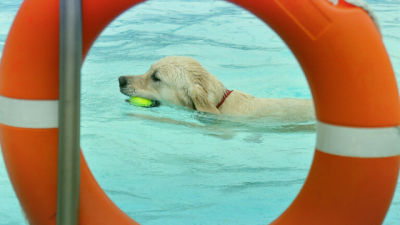Holistic Veterinary Therapies
Exploring Alternatives for Promoting Pet Health
 When discussing a course of treatment with your veterinarian, every option should be explored to ensure a pet receives the best care for their individual needs. Alternative veterinary therapies may be less commonly known or recommended than conventional medications or procedures. However, although research into most holistic remedies is still in the early stages, many treatments have shown the potential for alleviating several illnesses or injuries.
When discussing a course of treatment with your veterinarian, every option should be explored to ensure a pet receives the best care for their individual needs. Alternative veterinary therapies may be less commonly known or recommended than conventional medications or procedures. However, although research into most holistic remedies is still in the early stages, many treatments have shown the potential for alleviating several illnesses or injuries.
Alternative Medications
Hormone Replacement Therapy
Hormone imbalances in the adrenal gland may lead to a variety of health problems in cats and dogs, including Addison’s disease (caused by a deficiency of adrenal hormones) and Cushing’s disease (caused by an excess of adrenal hormone production). Another sign of adrenal dysfunction is pet allergies. The hormones cortisone and cortisol may be used to supplement the adrenal gland to regain balance and restore health.
Thyroid dysfunction is another common hormone imbalance. In the case of excess thyroid function in cats, anti-thyroid medications may be prescribed by a veterinarian to suppress thyroid production.
Spaying dogs deprives them of estrogen, which may lead to side effects such as urinary incontinence. According to Spaying and Incontinence in Dogs, “Proper function of urinary tract tissue is dependent upon adequate exposure to estrogen and after a pet’s ovaries are removed, her estrogen levels are low.” Common treatments often involve estrogen replacement therapy (ERT).
Cannabis Products for Dogs
Cannabidiol (CBD) is a non-psychotropic substance derived from the marijuana plant. Due to changing drug laws in the United States, many pet owners are curious about any possible medicinal effects of CBD oil. The American Veterinary Medical Association explains that “although cannabinoids such as CBD appear to hold therapeutic promise in areas such as the treatment of epilepsy and the management of pain and inflammation associated with osteoarthritis, the available scientific evidence pertaining to their use in animals is currently limited.”
A study by Cornell University showed that dogs suffering from osteoarthritic symptoms saw a “significant decrease in pain and increase in activity” when treated with CBD oil. At Colorado State University, another small study researched CBD’s effects on canine epilepsy, finding that “89 percent of dogs who received CBD in a clinical trial had a reduction in the frequency of seizures.” While both studies showed that cannabis-derived substances may hold potential for treating various ailments, the researchers agreed that the scope of their studies was too small to yield definitive answers and that further research using larger groups under more controlled circumstances is warranted.
Physical Therapy
Pet physical therapy—referred to as pet rehabilitation—uses stretches, exercises, and strengthening techniques to restore range of motion, mobility, and health. Dr. Jennifer Coates states that it is often used post-surgery or to treat musculoskeletal problems, but “is also used for neurological conditions, weight management or improving athletic performance.” Types of pet rehabilitation include:
- Applying heat or cold
- Walking up and down ramps and stairs
- Repeated sit/stand exercises
- Weaving through poles or cones
- Stepping over horizontal blocks or poles set at varying distances and heights
- Using exercise balls
- Standing on a rocker, wobble board, or balance blocks
- Adding weights for resistance training
- Neuromuscular electrical stimulations
- Transcutaneous electrical nerve stimulation
- Therapeutic ultrasound
- Extracorporeal shockwave therapy
- Use of harnesses, slings, prosthetics, etc.
Herbal Therapies for Cats
According to Vladimir Negron’s article for PetMD, 10 Herbs to Improve Your Cat’s Health, some plants may be grown at home for medicinal use for cats:
- Catnip – Relieves stress, anxiety, and nervousness; may be used as a “tea bath” or itchy skin
- Cat Thyme – May be used for the same purposes as catnip (for cats that may not respond to catnip)
- Valerian – May act as a stimulant, inspiring overweight cats to exercise
- Chamomile, calendula, echinacea – Alleviates certain skin issues
- Licorice root – Naturally soothes itching; may help treat endocrine, digestive, or respiratory issues; cleanses the blood; may have anti-inflammatory properties
- Cat’s claw and dandelion root – May help itching related to allergies; feeding dandelion root helps weight concerns
- Goldenseal – Naturally disinfects wounds; may alleviate eye swelling from allergies or infections
As with any treatment, whether conventional or holistic, always consult your veterinarian about whether a specific therapy is good—and safe—fit for your pet’s individual needs.
Hydrotherapy
Although veterinary uses of hydrotherapy were originally developed for racing animals (such as horses or Greyhounds), treatment availability has expanded to other dogs and cats. Sessions are supervised by one or more veterinarians, veterinary technicians, or certified rehabilitation practitioners. Life vests are used unless the animal is already a confident swimmer.
In The Benefits of Hydrotherapy for Your Dog, C.J. Puotinen writes that “hydrotherapy stimulates the cardiovascular and lymph systems, strengthens muscles, and allows painful joints to move comfortably.” This form of therapy may be particularly effective in improving the quality of life of geriatric dogs, improving agility and energy levels. Because it promotes muscle strength and mobility, hydrotherapy is also helpful in preventing injuries.
Canine patients have benefited from hydrotherapy treatments for myriad conditions, including:
- Physical Conditions
- Arthritis or joint pain
- Hip or elbow dysplasia
- Ligament ruptures
- Bone fractures
- Difficulty exercising due to obesity
- Neurological Conditions
- Degenerative myelopathy
- Spinal strokes
Hydrotherapy uses a swimming pool or special underwater treadmill, typically filled with water heated to 80-88°F. The water level is gradually increased to acclimate the dog to its surroundings. Puotinen adds that saltwater is sometimes used because it’s “similar to the body’s own internal fluids and which is said to allow magnesium and potassium to be drawn into the blood stream while toxins are eliminated.”
Choosing hydrotherapy depends on the individual circumstances of the patient. Pets with certain conditions (such as heart issues or with open wounds) should not receive hydrotherapy. Others may not have the temperament to benefit from the process; for example, some animals have a severe fear of water or are too aggressive to be safely handled by the staff. Some pet owners may also encounter the obstacles of availability of this treatment, as the sessions may be expensive, time-consuming, or require travel.
Massage
Dr. Kevin Fitzgerald’s How Massage Can Help Your Dog explains that massaging may “reduce stress and anxiety, increase circulation, decrease pain, and strengthen the bond between you and your dog. Also, it can help to identify new growths at an early stage.” Massages are generally used for alleviating symptoms of arthritis but are also beneficial for warming up joints before activities or to soothe muscles after the activities are complete. While similar to hydrotherapy in treating muscle or joint conditions, one advantage is that the owner can learn to massage their pet at home, eliminating the obstacles of expense and travel.
Examples of Other Alternatives
Acupuncture and Acupressure
Acupuncture uses needles inserted at specific parts in the body where nerves and blood vessels converge. According to Dr. Lynn Buzhardt, “the needles enhance blood circulation which improves healing ability. Acupuncture also stimulates the nervous system and increased the release of anti-inflammatory and pain relieving substances to reduce a dog’s discomfort.”
Uses for acupuncture include pain-relieving treatments for:
- Arthritis, joint inflammation, or joint disease
- Hip dysplasia
- Chronic back pain
- Serious spinal cord conditions
Acupuncture may also be used to complement treatments for:
- Issues associated with cancer or side effects of cancer treatments (such as inflammation, nausea, or impaired appetite)
- Impaired organ function
- Diabetes
- Pancreatitis
- The thyroid conditions of Cushing’s disease or Addison’s disease
Acupuncture sessions generally last 20-30 minutes. While there are few side effects to acupuncture therapy, some dogs may be stiff or tired for a day or two afterward. Acupuncture may be advantageous for patients that are in weak condition as it typically has no systemic side effects.
Acupressure is a similar, but less invasive, technique. This similar technique applies pressure to the points instead of inserting needles. Dr. Buzhardt says this method is “preferred for locations that are hard to reach with needles, or for dogs that may not tolerate the needles.”
Laser Therapy
Laser therapy (sometimes referred to as photobiomodulation) applies light to living tissues to promote health and wellbeing. According to Dr. Sarah Wooten, this method “harnesses laser light therapy to reduce pain and inflammation and improve tissue repair.” Dr. Brennen McKenzie writes: “The wavelength and power of the laser, the location and duration of exposure, the number of treatments, and many other variables are crucial to the effects achieved.” For medicinal purposes, low-level lasers are generally used.
Typically, low-level laser therapies include facilitating the healing of wounds and reducing inflammation and pain. Several other possible treatments have been suggested, including:
- Allergies
- Gingivitis
- Bacterial and viral infections
- Poisoning
Like many alternative therapies in veterinary medicine, laser therapy’s benefits are not known definitively. Dr. McKenzie summarizes: “Some positive effects have been reported, but no consistent pattern of clinical benefit has yet emerged.”
Conclusion
As researchers learn more details about the medicinal properties and uses of these alternative remedies, more choices should become available for pet owners looking to improve the lives of cats, dogs, and other animals. In the meantime, if you have a sick pet, talk to your veterinarian about whether any alternative therapies might meet their specific treatment needs. Many holistic methods of treatment show the potential to help restore and optimize pet health, but should only be pursued under professional supervision.
- American Veterinary Medical Association. Cannabis use and pets: What Veterinarians Need to Know. AVMA.org. https://www.avma.org/KB/Resources/References/Pages/Cannabis-Use-Pets.aspx. Accessed September 2019.
- Buzhardt L. Acupuncture/Acupressure for Dogs. Veterinary Centers of America Hospitals. LifeLearn Inc. 2015. https://vcahospitals.com/know-your-pet/acupuncture-acupressure-for-dogs. Accessed September 2019.
- Coates J, rev. Help Pets Recover with Physical Therapy (Pet Rehabilitation). PetMD. https://www.petmd.com/blogs/fullyvetted/2013/jan/physical_therapy_for_pets-29676. Accessed September 2019.
- Fitzgerald K. How Massage Can Help Your Dog. American Kennel Club. October 12, 2018. Originally published in AKC Family Dog.
- Gamble LJ, et al. Pharmacokinetics, Safety, and Clinical Efficacy of Cannabidiol Treatment in Osteoarthritic Dogs. Frontiers in Veterinary Science. Jul 2018:5(165).
- Guiden M. Preliminary data from CBD clinical trials ‘promising.’ Colorado State University. July 19, 2018. https://cvbms.sourse.colostate.edu/preliminary-data-from-cbd-clinical-trials-promising/. Accessed September 2019.
- McKenzie B. Uses, evidence, and safety of laser therapy. Veterinary Practice News. August 16, 2018. https://www.veterinarypracticenews.comc/uses-evidence-and-safety-of-laser-therapy/. Accessed September 2019.
- Miller ME. CBD for Dogs: Everything You Need to Know. PetMD. https://www.petmd.com/dog/general-health/cannabis-oil-dogs-everything-you-need-know?utm_source=NewsletterSubscribers&utm_medium=Email&utm_content=031720Newsletter&utm_campaign=Newsletter. April 2017. Last accessed July 2020.
- Petersen C. Adrenal Fatigue in Dogs and Cats. Pet Health, a division of Women’s International Pharmacy, Inc. http://pethealthpharmacy.com/adrenal-fatigue-in-dogs-and-cats/. October 2016.
- Petersen C. The Cortisol Connection: How Adrenal Hormones Affect the Health of Pets (and Their Owners). Pet Health, a division of Women’s International Pharmacy, Inc. http://pethealthpharmacy.com/cortisol-connection/. January 2017.
- Petersen C. Hyperthyroidism in Cats. Pet Health, a division of Women’s International Pharmacy, Inc. http://pethealthpharmacy.com/hyperthyroidism-in-cats/. December 2017.
- Petersen C. Spaying and Incontinence in Dogs. Pet Health, a division of Women’s International Pharmacy, Inc. http://pethealthpharmacy.com/spaying-and-incontinence-in-dogs/. January 2016.
- Negron V. 10 Herbs to Improve Your Cat’s Health. https://www.petmd.com/cat/wellness/evr_ct_herbs. PetMD. April 2009. Accessed October 2020.
- Puotinen CJ. The Benefits of Hydrotherapy for Your Dog. The Whole Dog Journal. November 2011; Updated April 2019. https://www.whole-dog-journal.com/care/the-benefits-of-hydrotherapy-for-your-dog/. Accessed September 2019.
- Stillabower A. Marijuana Toxicity in Pets. Pet Poison Helpline. https://www.petpoisonhelpline.com/pet-safety-tips/marijuana-toxicity-pets/. Accessed September 2019.
- Wooten S. Holistic Pet Care Options You May Not Know About. PetMD. https://www.petmd.com/dog/holistic-pet-care-options-you-might-not-know-about-1?utm_source=NewsletterSubscribers&utm_medium=Email&utm_content=092220Newsletter&utm_campaign=Newsletter. August 2018. Accessed October 2020.
Written by Laura Strommen
Edited by the Staff at Pet Health
© Pet Health, a division of Women’s International Pharmacy, Inc.





